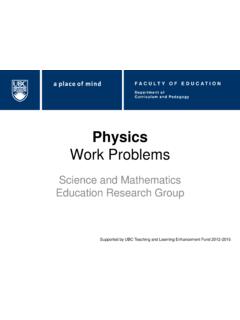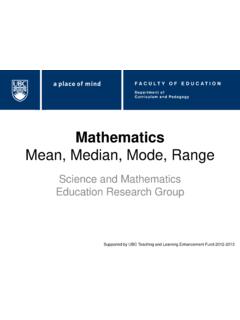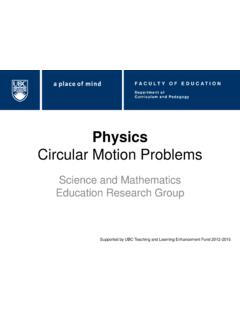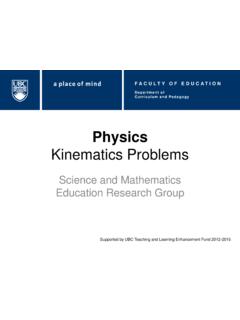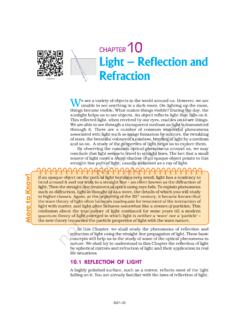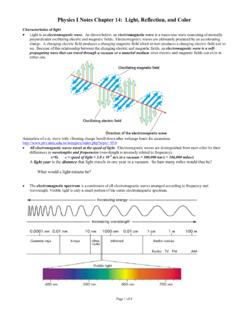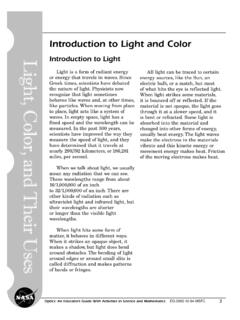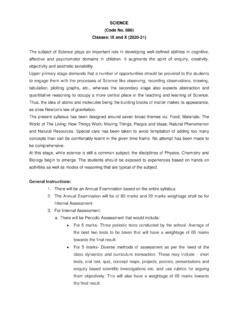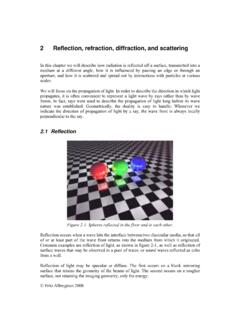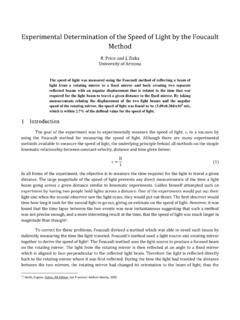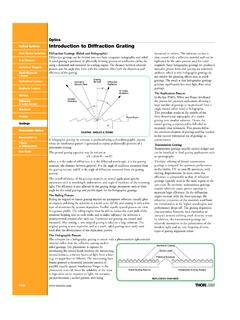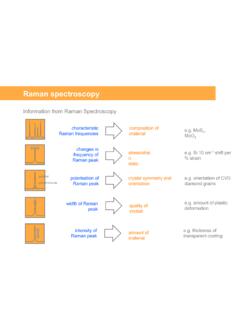Transcription of Physics Optics: Plane Mirrors - University of British Columbia
1 Physics Optics: Plane Mirrors Science and Mathematics Education Research Group Supported by UBC Teaching and Learning Enhancement Fund 2012-2014 D e p a r t m e n t o f C u r r i c u l u m a n d P e d a g o g y F A C U L T Y O F E D U C A T I O N a place of mind Featured Image m m m m m Plane Mirrors I If you are standing 1 m in front of a Plane mirror, what is the distance between you and your reflected image? 1 m d = ? Solution Answer: E Justification: For Plane Mirrors , the reflected image (a virtual image) and object are along the same line, perpendicular to the reflective surface. The image and object are equidistant from the mirror. If you are 3 m in front of the mirror, your reflected image will be located 3 m behind the mirror. Thus, the distance between you and the image will be 6 m. The reflected image s distance from the mirror is constant, and does not change if the observer moves from left to right.
2 1 m d = 2 m 1 m Solution Cont d Think about the image created here. Plane Mirrors do not provide any magnification, so the image must be the same size as the object. We can see that the image is created at the extension of the reflected rays. From this, we know that the triangles created by the light rays are equal on both sides of the mirror, and the image and object are equidistant from the mirror. Extend your Learning: Experiment Measure the image distance using two candles and semi-reflective glass. Extend your Learning: Predict Think about the word below. What would the image look like if a mirror was placed along the edge AB? BD? CD? AC? What letters are unchanged if they are reflected horizontally? Vertically? Why are the letters on the front of an ambulance reversed? A B C D m/s m/s m/s m/s m/s Plane Mirrors II If you run towards a Plane mirror at a speed of 2 m/s, at what speed does the apparent distance between you and your image decrease?
3 Solution Answer: D Justification: Your distance from the mirror is always equal to the apparent distance of your image from the mirror (see first question). Let the initial distance between you and your image be d1. After you run for 1 s at 2 m/s, the distance between you and your image is d2. You have moved 2 m, and your image has moved 2 m, so the distance between you and your image has decreased by 4 m at a speed of 4 m/s. Your image approaches you at a speed of (d1 - d2)/(1s) = 4 m/s d1 d2 2 m 2 m Your initial position Image initial position Position after you run for 1s Image position after you run for 1 s Mirror Extend your Learning: Thought Experiment Think about being in a car on the highway. When cars approach you in the other direction, it appears they are going much faster than they actually are. When cars drive up beside you, they appear to be going slower.
4 Why does this happen? What impact does the speed of your car have on how fast the other cars appear to be going? If the speed with which you run towards the mirror decreases by half, the speed with which the distance between you and your image decreases changes by what factor? many 45 45 45 Plane Mirrors III A ray of light is approaching a set of three Mirrors as shown in the diagram. The light ray is approaching the first mirror at an angle of 45-degrees with the mirror surface. How many times will the ray reflect before it exits the system? Solution Answer: B Justification: The light reflects twice before it finally exits the system. Draw a normal at the point of incidence to the first mirror; measure the angle of incidence (45 ); then draw a reflected ray at 45 from the normal. The reflected ray will be parallel to the second mirror, and will not hit it.
5 The reflected ray will hit the third mirror at an angle of 45 , and will reflect up and out of the mirror system. 45 45 45 45 45 45 A. - Plane Mirrors IV A corner mirror is created when two Plane Mirrors are connected at a 90 angle. A light ray is incident at an angle, , to one face of a corner mirror as shown. It reflects off the second mirror and exits the system What will the angle of reflection be at the second reflection? Press for hint Solution Answer: A Justification: By the law of reflection, we know that the first ray reflects at an angle of with the mirror, and the second ray is incident at an angle of with the mirror. Given that the interior angles of a triangle sum to 180 , we know that = 180 - 90 - . Therefore the incident and reflected rays are parallel, and the angle of reflection at the second mirror is.
6 = 90o - Extend your Learning: Simulation Test out various incident rays in a corner reflector. Extend your Learning: Video Title: Astronauts left reflectors and other PooP on the Moon! ft. MinutePhysics enough information Plane Mirrors V A horizontal light ray strikes a mirror such that the reflected ray is directed at a 60 angle with respect to the horizontal. What is the angle, a, that the mirror makes with the horizontal? 60o a Solution Answer: C Justification: Let s divide this system into four angles: a, b, c, and d. = b (alternate angles) = c (opposite angles) a = b = c = d (law of reflection) a = b = d know that c + d = 60 We can substitute a = c and a = d into c + d = 60 c + d = a + a = 2a = 60 . Dividing both sides by 2, a = 30 60o a b c d and 3 and 4 and 3 locations possible Plane Mirrors VI A purple star is between two floating barriers, above a Plane mirror, as shown below.
7 From which locations would an observer be able to see the object? 1 2 3 4 barrier barrier mirror object Solution Answer: A Justification: The diagram below depicts the reflections that would need to occur for each of the images to exist. The red rays pass directly through a barrier, which is impossible. Images 2 and 4 cannot exist. barrier barrier mirror object 1 2 3 4 image Solution Cont d Another way to think about this question is to figure out the whole possible range of space an observer could stand in and still be able to see the reflection. The blue regions represent the swept-out areas in which incident rays will reflect to the other side of one of the barriers. In these regions, light rays have not collided with the barriers. At these locations, an observer would be able to see the image of the object. barrier barrier mirror object 1 2 3 4 2 3 Extend your Learning: Video Title: What is Parallax?
8 Where do you observe parallax in everyday life? How can a Plane mirror help you overcome parallax? Plane Mirrors VII You are trying to buy a new mirror for your bedroom, and you want to get one that will allow you to see your entire body at one time. What is the minimum length the mirror must be so that you can see your entire body? height quarter height height height B. H C. H D. H Solution Answer: C Justification: The object and observer are connected by a reflection triangle. The angles of incidence and reflection are equal. If the object and observer are equidistant from the mirror, an isosceles triangle is created by the incident and reflected rays. The line normal to the mirror bisects the distance between the object and observer. The image is formed directly behind the mirror, in line with the object. Object Observer The solution is continued on the next slide.
9 Solution Cont d When you stand in front of a mirror, light bounces from your toes on to the mirror, and then up to your eyes. The light hits the mirror half way between your eyes and your toes. The solution is continued on the next slide. Solution Cont d In order to see your whole body, a mirror half your height is needed. Extend your Learning: Experiment Find a mirror and test this out. If you don t have a full-size mirror, use a smaller one and your head. Mark the top and bottom of your reflection at a variety of distances from the mirror. What do you notice about the distance between the marks? Plane Mirrors VIII Sandy and Robin are in a pitch black room with a mirror. To see the best image of their faces, they should: a light on the mirror a light in any direction in the room the light on their faces Solution Answer: C Justification: Shining the light at the mirror will only create a reflection of the light .
10 Shining a light anywhere in the room will provide some illumination of their faces. This will create a reflected image. However, the best image will be produced from shining the light directly on their faces. Think about the moon. The reason we can see it so clearly on Earth is because the sun shines on it directly, and that light is reflected back to us. Extend your Learning: Video Title: Future of Invisibility cloaks Plane Mirrors IX Two Plane Mirrors are joined at 90 degrees to create a right angle mirror. How many images are produced when an object is placed between them? many Note: This is one example of an object location, this occurs for all locations. Solution Image 1 Image 2 Observer Object Answer: C Justification: There is one virtual image directly behind each mirror (images 1 and 2). The light entering your eyes that appears to come from these images has undergone one reflection.

